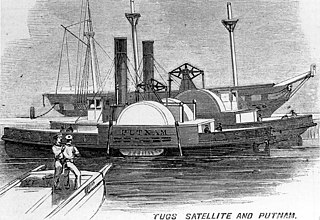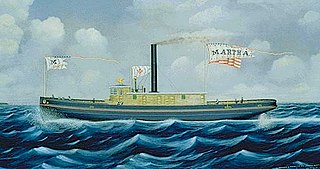USS Alert was a 90 long tons (91 t) steamship named A. C. Powell purchased by the Union Navy during the first year of the American Civil War.

The first USS Pawnee was a sloop-of-war in the United States Navy during the American Civil War. She was named for the Pawnee Indian tribe.

The first USS Seminole was a steam sloop-of-war in the United States Navy during the American Civil War.

USS Young America was a Confederate steamer captured by the Union Navy’s blockade vessels, and subsequently placed in-service in the Union Navy during the American Civil War.
USS Zouave was a steamer acquired by the Union Navy during the American Civil War. She was needed by the Navy to be part of the fleet of ships to prevent blockade runners from entering ports in the Confederacy.

USS General Putnam – also known as the USS William G. Putnam – was acquired by the Union Navy during the first year of the American Civil War and outfitted as a gunboat and assigned to the Union blockade of the Confederate States of America. She also served as a tugboat and as a ship's tender when so required.
USS Shawsheen was a steam operated tugboat acquired by the Union Navy during the American Civil War.
USS Unit was a steamer acquired by the Union Navy during the American Civil War.
USS Laburnum was a steamer acquired by the Union Navy during the American Civil War. She was used by the Navy as a tugboat and dispatch boat to serve Union ships on blockade duty.

USS Cohasset was a tugboat acquired by the Union Navy during the American Civil War. She was used by the Union Navy for various purposes: as a tugboat, dispatch vessel, escort vessel, and even as a gunboat.
USS Martin was a steamer acquired by the Union Navy during the American Civil War. She was used by the Union Navy for various tasks, including those of a torpedo boat, tugboat, and a picket boat, patrolling Confederate waterways to prevent the South from trading with other countries.
USS Belle was a steamer acquired by the Union Navy during the American Civil War.

USS Bazely was a steamer acquired by the Union Navy during the American Civil War. She was used by the Union Navy in a tugboat/patrol boat role in support of the Union Navy blockade of Confederate waterways.
USS Rose was a screw steamer acquired by the Union Navy during the American Civil War.
USS Althea was a screw steamer acquired by the Union Navy during the American Civil War. The Union Navy used her as a tugboat, a torpedo boat, and as a ship's tender in support of the Union Navy blockade of Confederate waterways.
USS Harcourt was a small steamship acquired by the Union Navy during the American Civil War. She was placed into service as a tugboat and assigned to the blockade of ports of the Confederate States of America.
USS Pink was a steamer commissioned by the Union Navy during the American Civil War. She served the Union Navy's struggle against the Confederate States of America in various ways: as a tugboat, a gunboat, and as a small transport.
USS Poppy was a steamer commissioned by the Union Navy during the American Civil War.

USS Violet was a 166-ton steamer acquired by the U.S. Navy for use during the American Civil War.

The second USS Suwannee and third USS Mayflower was a United States Lighthouse Board, and later United States Lighthouse Service, lighthouse tender transferred to the United States Navy in 1898 for service as an auxiliary cruiser during the Spanish–American War and from 1917 to 1919 for service as a patrol vessel during World War I. She also served the Lighthouse Board and in the Lighthouse Service as USLHT Mayflower from 1897 to 1898, from 1898 to 1917, and from 1919 to 1939, and in the United States Coast Guard as the first USCGC Mayflower (WAGL-236) in 1939 and from 1940 to 1943 and as USCGC Hydrangea (WAGL-236) from 1943 to 1945.







